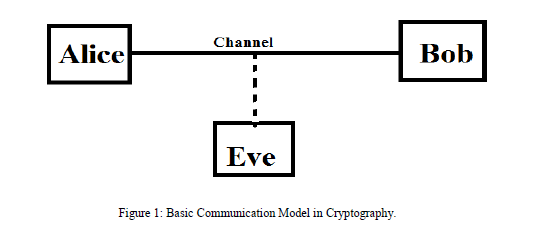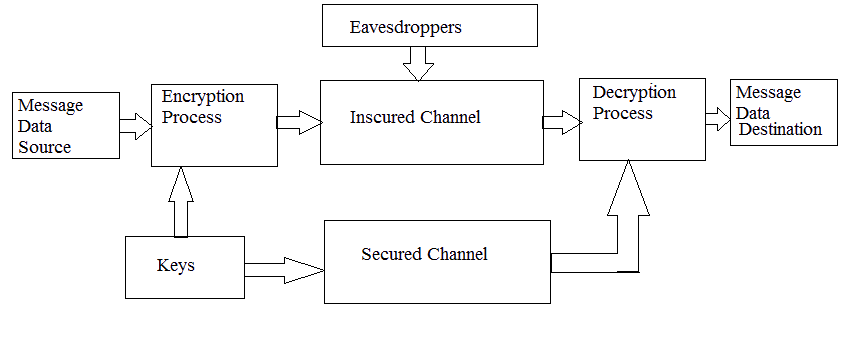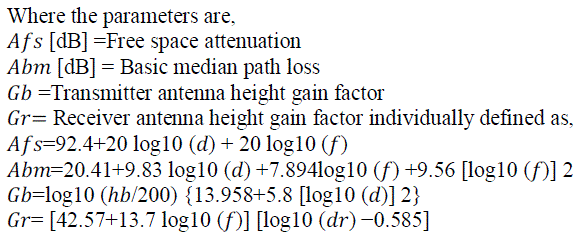ISSN ONLINE(2320-9801) PRINT (2320-9798)
ISSN ONLINE(2320-9801) PRINT (2320-9798)
Kiran J. Parmar1 and Dr. Vishal D. Nimavat2
|
| Related article at Pubmed, Scholar Google |
Visit for more related articles at International Journal of Innovative Research in Computer and Communication Engineering
Radio propagation models are focus on realization of the path loss with supplement task of predicting the coverage area for a radio transmitter. Radio propagation models are empirical in nature and are developed based on large collection of data for the specific scenario. The aim of this paper is to study of different path loss propagation models in radio communication at different frequency band. Like SUI model, Hata model, Okumura model, COST-231 model, ECC-33 model and W-I model.
Keywords |
||
| Empirical, Deterministic and Stochastic path loss propagation models and free space path loss models. | ||
I. INTRODUCTION |
||
| Radio propagation models are an empirical mathematical formulation for the characterization of radio wave propagation as a function of distance between transmitter and receiver antenna, function of frequency and function of other condition. A propagation models are usually developed to predict the behavior of radio propagation in different environment and different condition. Radio propagation models are empirical in nature and models are developed based on large collection of data collected for the specific scenario. For any propagation models the collection of data has to be sufficiently large to provide enough scope for all kind of situations in specific scenario and terrain. Propagation model are very useful in network planning and performing interference studies as the deployment proceeds. This model can be broadly classified into three types namely Empirical, Deterministic and Stochastic [10]. | ||
Empirical:- |
||
| An empirical model is based on observation and measurements alone. These models are mainly used for predict the path loss. It can be further classified into two sub part namely non time dispersive and time dispersive. The Stanford University Interim model is one of the perfect examples of time dispersive models. The models like Hata model, COST-231 Hata model, ITU – R model are the best example of non-time dispersive models. | ||
Deterministic:- |
||
| Deterministic models are deployed laws of governing electromagnetic wave propagation for determination of received signal power at a particular location. These kinds of models often require a complete 3D map of the propagation environment. Ray-tracing models are the best example of the deterministic model [14]. | ||
Stochastic:- |
||
| These models are used in terms of random variables. Stochastic models are the least accurate but this model requires the least information about the environment and use much less processing power to generate predications. These are mostly used for predication at above 1.8GHz. | ||
II. RELATED WORK |
||
| In [1] used COST231 Hata, COST231 W-I, ECC-33, Ericsson 9999, SUI propagation models to calculate path loss in different terrain Show that due to some environment impairments and NLOS condition in urban area, this models simulates higher path loss compared to suburban and rural areas. Find that not a single model that suits for all the terrain condition. SUI model shows minimum path loss in urban and suburban area but not in rural area when compared to other models. COST231 W-I model shows minimum path loss in rural area when compared to urban and suburban areas, this model perform better in urban and suburban areas. In [2] Used UFPA (Modified SUI), SUI and Extended COST231-Hata model to predict path loss and find suitable model in 5.8 GHz band. Show that modified SUI was not best; it presented an error slightly larger than the SUI. The extended COST231-Hata did not fit in general. In [3] Discuss and compare following path loss models – Free Space Path Loss Model (FSPL Model), Hata-Okumura Extended Model (called also ECC-33 Model), Cost 231 Walfish-Ikegami Model and Stanford University Interim Model. Found that no single model is suited for all environments at 3.5GHz frequency band. FSPL model show minimum path loss for all type of environment. ECC-33 and COST 231 W-I model are most usable in densely populated areas, but in rural area they are not so accurate. In [4] measured received signal power values are compared to predicted values of the COST 231 model. Result showed that for LOS, the COST 231 was able to closely predict measured value. | ||
III. FREE SPACE PATH LOSS MODELS |
||
| Path loss occurs in free space can be defined as the ratio of the transmitter power to receiver power in free air and it is expressed in decibels. Free space path loss is diverse on frequency & occurs, PL=10 n |
||
| Where the parameters are, | ||
| n = path loss exponent. | ||
| The value of path loss exponent for free space model is always 2[8]. | ||
| F [MHz] = Frequency of operation. | ||
| D [m] = Distance between transmitter & receiver. | ||
1) Stanford University Interim (SUI) model |
||
| Working group of IEEE 108.16 proposed this standard for the frequency range below 11GHz. The proposed standards for frequency range below 11GHz contain the channel model developed by Stanford University namely the SUI model. SUI model has been derived as an extension to Hata model with 1900 MHz frequency band and above. The SUI models are sub divided into three different types, namely A, B & C in this Type A is associated with path loss and it is very useful for hilly terrain with moderate to heavy densities. Type B model is very useful for flat terrains with moderate to heavy tree densities and hilly terrains. Type C is associated with the minimum path loss and applicable for flat terrain with light tree densities. | ||
| The fundamental path loss expression for the SUI model along with correction factors is as [4] | ||
| Where the parameters are, | ||
| D [m] = Separation of transmitter and receiver | ||
| d0 [m] = 100 | ||
| λ [m]= Wavelength | ||
| Xf [MHz] = Correction factor for frequency > 2GHz | ||
| Xh [m] = Correction factor for receiving antenna height | ||
| S [dB] = Correction factor for shadowing effect (value between 8.2dB to 10.6dB) | ||
| γ= Path loss exponent | ||
2) Hata Model |
||
| Hata model is simply the empirical formulation of the graphical path loss data produced by Okumura model and it is valid from 150MHz to 1500MHz frequency range. It predicted the median path loss for the distance d from transmitter to receiver antenna up to 20Km and the transmitter antenna height is considered 30m to 200m and receiver antenna height is 1m to 10m. This model is presented in the urban area propagation loss as a standard formula and supplied provide correction equations for suburban and rural areas. | ||
| Median path loss (dB) of Hata model is given by [15]. | ||
| Where the parameters are, | ||
| f c [MHz] = Frequency | ||
| ht [m] =Height of base station antenna | ||
| hr [m] =Height of mobile station antenna | ||
| I [Km] = Tx− Rx separation | ||
| a(hr) =Antenna height correction factor for the receiver antenna as a function of coverage area. | ||
3) Okumura model |
||
| The Okumura model is classical empirical model to measure the radio signal strength in built up areas. This model is perfect in those cities which having dense and tall structure. This model was framed on the basis of accumulated data from Tokyo city of Japan [10]. This model is applicable for less than 3GHz frequency range. By using this model we calculate the path loss in urban, sub-urban and rural area. | ||
| Median path loss model can be expressed as [13] | ||
| Where the parameters are, | ||
 |
||
IV. COST 231 HATA MODEL |
||
| Cost 231 Hata model is used to predicting path loss in mobile wireless system. Cost 231 Hata model is initiated as an extension of Hata model. It is used for predicted the path loss in different environments like urban, sub urban and rural. It is designed for 500MHz to 2000MHz frequency range. The basic path loss equation in dB is [6] [16]. | ||
 |
||
4) Hata – Okumura Extended model or ECC-33 model |
||
| Hata – Okumura model is most usable in empirical propagation model, which is based on the Okumura model. It is well established model for the UHF band. Recent recommendations of ITU-R i.e. P.529, this model use up to 3.5GHz but data greater than 3GHz is not yet provided. Path loss of the ECC-33 model is defined as [6] | ||
 |
||
5) WALFISCH - IKEGAMI PROPAGATION MODEL |
||
| This model is the combination of the models from J. Walfisch and F. Ikegami. This empirical model was developed by the COST-231 project. It is also called Empirical COST- Walfisch- Ikegami [10]. | ||
| The accuracy of this model is quite high because in urban area especially the propagation over the rooftop is the most dominant part. This empirical model considers only the buildings in the vertical place between the transmitter antenna and the receiver antenna. | ||
| This model is applicable only for the frequency range between 800 to 2000MHz, height of the transmitter antenna "hTX" is 4 to 50m, and height of the receiver antenna "hRX" is 1 to 3m and distance “d” between transmitter and receiver antenna. This model is distinguishes between two situations, the “line of sight” and the “non-line of sight” situations. | ||
LOS situation:- |
||
| In this case the path loss predication is very easy. Equation for the path loss predication is. | ||
| N-LOS situation: - PLLOS = { SL + Lrts + Lmsd f or urban & sub-urban LFS if Lrts + Lmsd > 0 } | ||
| Where the parameters are, | ||
| LFSL =Free space loss | ||
| Lrts = Roof top to street diffraction | ||
| Lmsd = Multiscreen diffraction loss | ||
V. COMPARISON |
||
| From the above study, all outdoor propagation models can compare on the basses of their frequency band and terrain. | ||
VI. CONCLUSIONS |
||
| This study has given the brief introduction of radio propagation models. The major parameters which characterize the radio propagations models h, f, Tx, Rx were introduced. Each model has its own characteristic to use in the different environment. Found that not a single model is suitable for all environments. Free space path loss model is basic models for finding the path loss in free space. SUI models showed quite large path loss prediction errors. Hata model predicted the median path loss at 20Km distance from Tx to Rx. COST-231 Hata model generally predicate the path loss at greater antenna heights. ECC-33 model highly recommended for urban environments. WI models have high accuracy and generally use in urban environment. | ||
Tables at a glance |
||
|
||
References |
||
|